What is a Referring Domain? A Simple Guide
Join the 1,000+ brands that trust us for their link building.
Backlinks are one of the most important ranking factors. We’ve emphasized this before and we’re emphasizing it again. The power of quality backlinks is what propels websites up in the SERPs. They signal trust to Google that your website contains valuable content that should be displayed to search engine users. They also establish relevance between your content and other sites.
But not all backlinks are created equal (another favorite saying of ours). The key is to get backlinks from the best websites possible. These websites are also called referring domains, and backlinks from authoritative referring domains really make a difference when it comes to ranking.
This article is going to talk about backlinks from a slightly different perspective — that of referring domains.
You’re going to learn what referring domains are and how to check for them. You’re also going to understand how referring domains are valuable to SEO and necessary for establishing authority/credibility.
Now, let’s start with examining what referring domains are:
What is a Referring Domain?
“Referring domains” goes by two other names: external websites and linking domains. They’re essentially like backlinks, except they refer to an entire website and thus capture the overall value of that website. In the world of SEO, a referring domain (RD) is generally a metric used for analysis.
Technically speaking, a referring domain is a unique website that links out to a target website (aka linked domain) and may direct traffic to that site through one or more of its outbound links. In turn, the target website can receive one or more of those backlinks from the referring domain. The referring domain can also point to a URL, subdomain, or subfolder of a target website.
In terms of an entity-relationship model, a referring domain is a unique entity that can send one or many outbound links to one or many unique target websites. Conversely, a target website is an entity that can receive one or many backlinks from one or many referring domains.
This complex relationship looks like this:
For example, your website can receive 1 backlink from RD A, 4 backlinks from RD B, and 6 backlinks from RD C. This means your website will have 11 backlinks from 3 referring domains.
It’s common for websites to link out to a single website multiple times. It’s less common for websites to only send one backlink to another website (but not unusual). This is why many websites have fewer referring domains than backlinks — some of the referring domains are linking out to the websites multiple times.
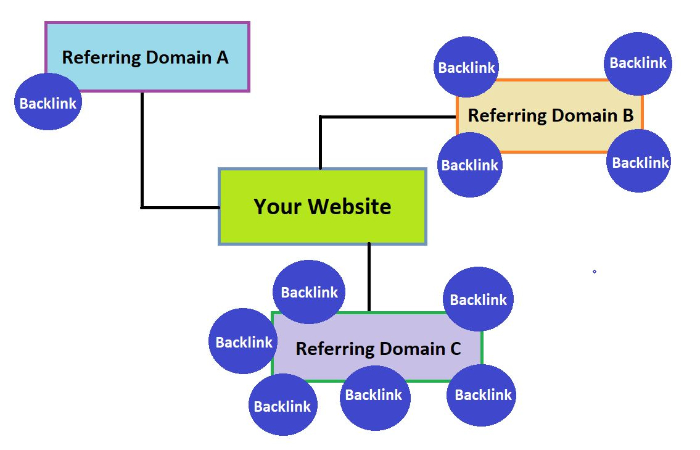
How Does a Referring Domain Differ From a Backlink?
Referring domains and backlinks are slightly different. A backlink is an inbound hyperlink from other websites to yours. It’s basically a link that directs traffic to one of your web pages. So the process of linking incoming traffic to your web pages creates these meaningful tools called backlinks and signals a vote of confidence in your domain to search engines like Google.
Your website gets linked to by other web sources if they consider your content to be useful, credible, and relevant. As previously mentioned, your website can receive any number of backlinks from one or many linking domains.
This is why you want your web pages to always contain linkable assets like informational content, blog posts, videos, and infographics. This is the type of content/media that visitors want to view and why backlinks are important to search engines, affiliate marketers, and referral traffic (to name a few).
For visitors from referral traffic, backlinks provide a reference to useful and relevant information about a subject, product, or service. Think of a consumer shopping for athletic shoes and clicking on a backlink to a relevant online retailer.
Search engines use backlinks to determine a domain’s authority (i.e. website’s credibility) and a web page’s ranking in the SERPs. Marketers use high-quality links to improve their rankings and send traffic to their target sites.
A powerful, high-quality backlink serves as a conduit for passing authority to your website to help improve its search engine ranking. The more high-quality backlinks your domain can procure, the stronger its backlink profile becomes. A strong and diverse backlink profile is what gives authority to a domain and boosts its rankings.
Check out this article on the benefits of link building for more information.

So now that we explained why backlinks are important and how a collection of backlinks makes up the link profile of a referring domain, let’s talk a bit more about what makes referring domains different from backlinks.
For analytical purposes, a referring domain contains a lot more information than a backlink. This is because referring domains often contain numerous backlinks that comprise the referring domain’s link profile. These link profiles either strengthen or weaken a referring domain and any of its linked domains.
When you’re analyzing a referring domain, you can examine data about that site’s backlink profile, every unique website it’s linking to, and the organic traffic to those target sites (and to the sites that contain the referring domain’s backlinks). It’s a more complete picture than looking at a backlink. It can also provide useful competitive intelligence — something we will go over in the next section.
We’ve gone over the difference between referring domains and backlinks. Now let’s go over how to check for referring domains.
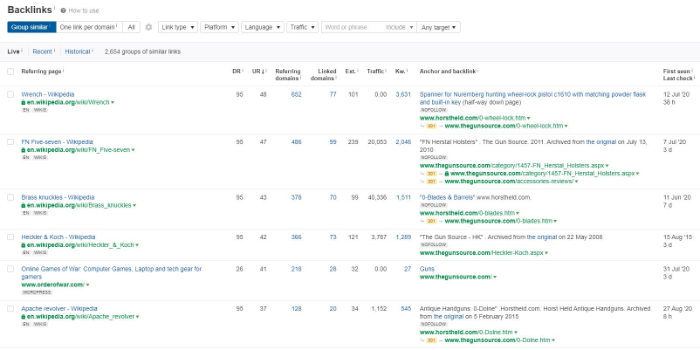
How to Check Referring Domains
There are many SEO tools that allow you to check for referring domains and backlinks. These tools include Ahrefs, SEMRush, Majestic, and SERanking. One of the best is the referring domains report provided by Ahrefs, which we’ll be discussing in greater detail.
After inputting your target address and choosing the mode for how deep your want your search report to be (e.g. URL, exact URL, prefix, domain with/without subdomains), the first thing you notice in the Site Explorer overview is a panel that shows the search result’s total number of backlinks and the total number of referring domains (based on Ahref’s most recent database update). The number of backlinks will more than likely be greater than the number of referring domains by several multiples.
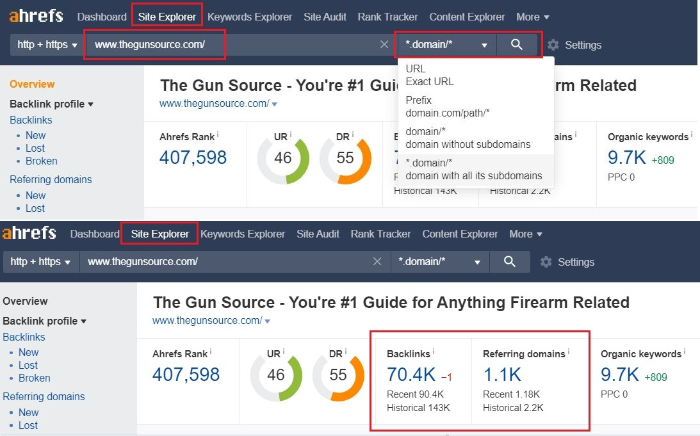
Clicking on the “Referring domains” number will bring you to the Referring Domains overview screen (which is a subsection of the Backlink profile section on the sidebar). It’s basically a data table displaying every referring domain pointing to the target site in question, along with various metrics like the organic traffic for each referring domain, the number of linking domains each referring domain has, and the total number of linked domains that each referring domain is pointing to.
This is where you can dive into some competitive analysis. First, you will want to bring up the Referring Domains overview for the competitor you want to spy on (Site Explorer -> Search -> Backlink profile -> Referring Domains).
Now you can see all the referring domains linking to that site. You can now search for any relevant websites that you can try to get backlinks from. Ultimately, you want to be doing the same things your top competitors are doing which can mean mimicking their backlink profile as closely as possible (and then improving upon it).
You’ll want to look for:
- Authoritative, well-known industry domains
- Relevant websites that appear to be about a similar topic to yours
- Sites using “dofollow” links (use the “dofollow” filter)
- Sites with high organic traffic (you can sort from high to low)
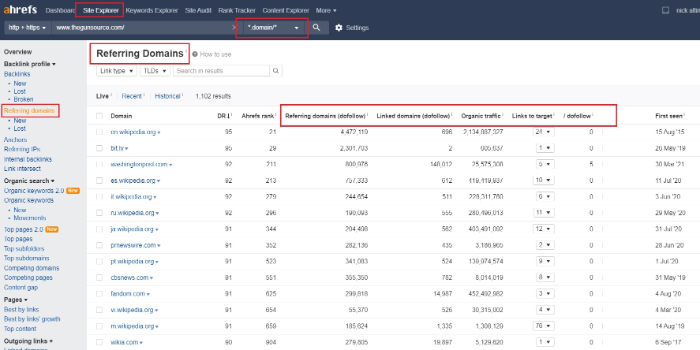
Now let’s say you see an interesting RD and want to examine it further. You can click on the drop-down menu under the “Links to target” column for that RD to see information on every backlink that’s pointing to your target site from that referring domain.
You’ll see additional data for each backlink such as its referring page, traffic, contextual anchor text, and hyperlink. The context of the backlink is especially useful for understanding how you could try to get a backlink from that referring domain as well.
Another piece of competitive intelligence you can gain from the referring domains overview is finding out who your competitor’s serial linkers are and how many times they are linking to your competitor’s website.
Serial linkers are essentially those referring domains that link to the same website many times. For practical analysis, you may want to filter “dofollow” RDs with at least 25 – 50 “Links to target”. Now you can dive deeper by expanding the drop-down menu for each serial linker.
You’ll want to look out for referring domains that have linked:
- From multiple pages or posts (as indicated by the “Referring page” column)
- In numerous contexts (as shown in the “Anchor and backlinks” column)
- On multiple occasions over a lengthy period of time (“First seen, Last Check” column)
That sums up some of the useful things you can check with Ahrefs’ referring domains explorer tool (and other SEO tools as well). Keep in mind that anything you analyze about competitors can be analyzed for your website too.
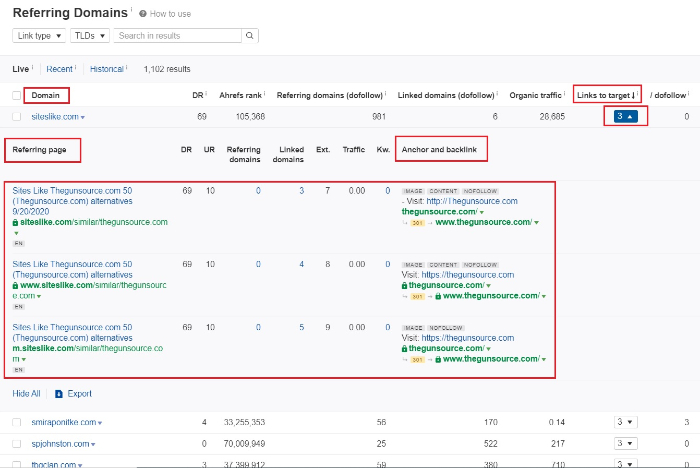
How Do Referring Domains Affect SEO?
Simply put, you need referring domains to get backlinks. And backlinks are crucial for getting organic traffic. Research on approx. 1 billion web pages have shown that roughly 91% don’t get a single organic visitor per month. And about 66% of the 1 billion pages have zero referring domains. Moreover, there is a strong positive correlation between a site’s total number of referring domains and its organic search traffic. Our article on how many backlinks per month is safe includes some related research that explains this trend in greater detail.
So, do you want more organic traffic? Yes? Then please pay attention to referring domains and always make them a focus of your link building campaign.
Our explanation of how backlinks act as a vote of confidence to Google in your website also applies to referring domains, but on a deeper level since referring domains are composed of many backlinks (i.e. link profiles).
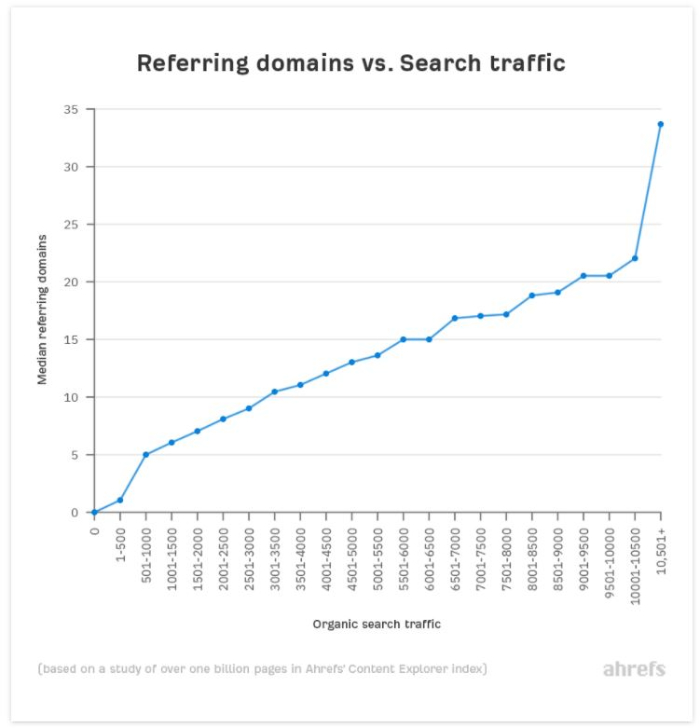
Backlinks are considered to be one of the top 3 most important ranking factors. Google analyzes many attributes of a backlink to determine its overall quality. One of these attributes is the quality of the linking domain that the backlink comes from. High-quality, authoritative linking domains will pass on that authority through their outbound links. This is why it’s ideal to get backlinks from authoritative websites.
Just like you want a lot of diverse backlinks, you also want as many quality referring domains as possible. For example, getting 100 backlinks from 10 referring domains looks a lot better than getting 100 backlinks from 1 referring domain.
Although it’s nice to get endorsed by the same website multiple times (in the form of multiple backlinks), the value of each backlink decreases each time that site sends you another link. In other words, there will be diminishing returns to each successive backlink gained from the same referring domain in the eyes of Google.
As an analogy, think of searching for a plumber on an online marketplace. You find two plumbers in your area that can fix your problem. One of them has 10 reviews from 3 or 4 people, and the other has 20 reviews from 18 people. Which one would you trust more?
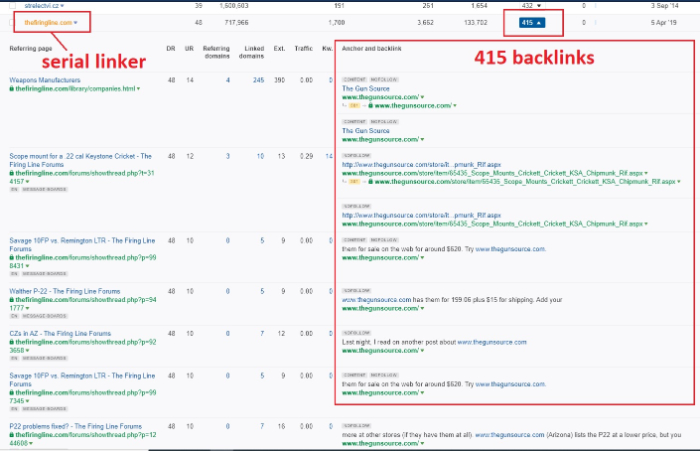
Just remember that Google devalues links that come from serial linkers (for obvious reasons like spam). Don’t expect much value from getting hundreds or thousands of backlinks from the same referring domain. It may look great that you’re getting thousands of backlinks, but if most of them are coming from low-quality websites, you’re not going to perform as well as you may think.
Your link building efforts should focus on getting backlinks from the best referring domains possible. Those that exhibit these qualities:
- Authoritative
- Trustworthy
- Strong backlink profiles
- Not serial linkers
- Relevant to your niche
Referring domains are web traffic sources that search engines like Google take seriously. They may represent your business relationships and reflect what your website is about. You want to be associated with as many high-quality referring domains as possible to maximize your performance in the SERPs. And you always want to focus your link building around getting more referring domains.
Ways to Get More Referring Domains Pointed at Your Site
Acquiring high-quality links from authoritative websites should always be one of your main focuses. You can center an entire link building strategy around adding quality referring domains to your site’s backlink profile. Let’s go over some ways of doing this:
Analyze a referring domains report
Find an SEO tool that offers a referring domains report, like Ahrefs, and use it as your starting point for analysis and strategy development. You’ll be at a disadvantage if you don’t use a report like this. They provide a lot of useful information like showing you every backlink coming from each referring page from a linking domain and allowing you to do competitor analysis.
Examine the competition
Analyzing the competition by scanning their link profile and list of referring domains will give you ideas on how to improve your situation and expand your referring domains network by finding partners they collaborate with. You will get ideas on how to earn more links and rank higher in the search results.
Identify the most reputable domains
This is about scanning your current backlink sources for the most authoritative domains in order to find partners you can work with to get more links from their referring pages. Identifying popular, well-respected domains in your industry/niche that aren’t linking to you yet is also important for getting new backlinks and should be part of your link building campaign.

Select the best destination pages
This is about finding specific pages to share your content on the best referring domains in order to drive traffic and acquire backlinks. This should be part of your link building campaign.
Identify your pages with the most backlinks
Identifying the pages that have your top-performing content (the pages with the most backlinks and referring domains) is a great starting point for optimizing your marketing strategies. You can build off the success of these pages by focusing your SEO strategies on developing them because you know they’re already liked and trusted.
Create great content
Content is one of the main drivers of backlinking, so your site is more likely to get links if it contains great content (i.e. linkable assets). An effective content marketing strategy can reach and expand your target audience, gain referral links, and increase conversions.
There are many ways to produce content:
- Publish informational content that shows you’re an authority on a subject.
- Write case studies that can help you gain notoriety in the industry.
- Create informational videos (Q&A, live support. how-tos) and infographics that visitors want to look at and share.
- Write press releases to create buzz around your products and services.
- Interviews, research papers, eBooks, guest blogging, etc.
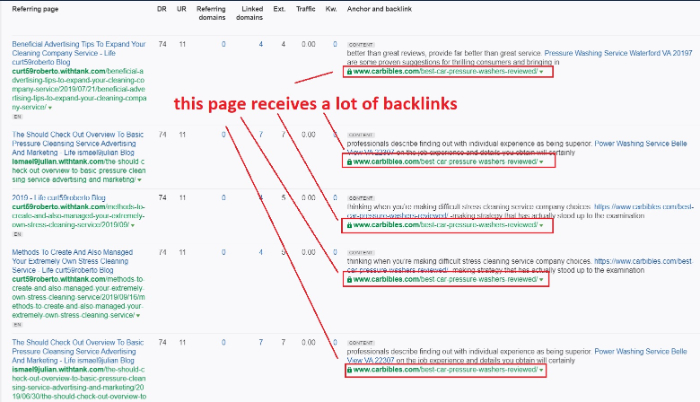
Distribute your content (i.e. linkable assets)
Shareable content is great for sending to high-quality referring domains that you’re interested in getting backlinks from. Reach out to webmasters with your articles and infographics.
Guest blogging is an excellent way to get yourself known as an expert in a field by writing for other authoritative websites. You can get author bio links from your blog post.
Sites like Help A Reporter Out (now Connectively) give you the opportunity to connect with journalists who need content for their stories in exchange for a backlink to your site.
Improve your audience targeting
Knowing your audience is the key to digital marketing and SEO. It will not only allow you to develop targeted content strategies and blog posts that engage visitors and decrease bounce rate, but targeting your audience will assist in your keyword research and increase the likelihood of your sites getting backlinks as well (and thus referring domains).
Improve your link building strategies
It never hurts to keep updating and improving your link building strategies by using best practices and incorporating more data-driven decisions by utilizing tools like referring domains reports.
This could mean that you decide to buy backlinks from an experienced link building service that knows how to reach out to niche domains.
Final Words
Hopefully this article has helped you understand what is a referring domain and the difference between referring domains and backlinks. Referring domains are unique websites that link back to target sites and direct traffic to them. A target website can have one or many referring domains and a referring domain can have one or many target sites. Typically, websites will have a high number of backlinks than referring domains by several multiples.
Referring domains are very important for SEO and link building strategies because they’re a ranking factor that can signal trust and authority to Google. But this depends on the quality of the referring domains. Backlinks from the most trusted, high-traffic domains are going to bring a lot more value than backlinks from low-quality websites.
There is a positive correlation between the number of referring domains a website has and its organic traffic. So don’t forget to focus on getting more referring domains during your link building campaign.
 Article by:
Article by:
Nicholas Altimore
Hey I'm Nick, the Founder/Director here at SirLinksalot. I have a passion for building online businesses and taking websites to the next level with the help of my amazing link building team.
 Questions or Comments?
Questions or Comments?
We are active in our Facebook Group seven days a week and would love to hear from you. Ask us questions, learn from other group members, and share your knowledge.
Related Posts
Ready To Start Building Your Rankings?
Your link building journey to the top of Google starts today!
Apply for Managed Link Building to get a free analysis and game plan, or order backlinks a la carte.
Link building services that work.


